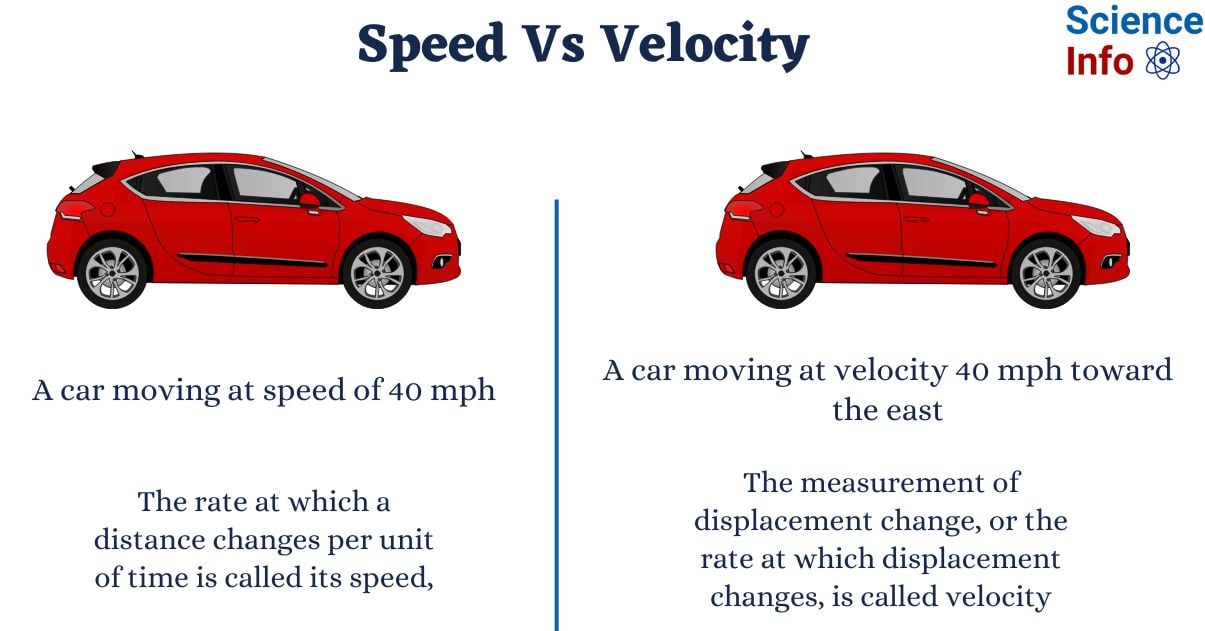Although the terms velocity and speed seem to denote the same thing. However, understanding the difference between these two ideas is crucial. The primary difference between speed and velocity is that velocity contains information regarding direction, but speed does not. Let us understand these two concepts in more detail so that we can find out the difference between speed and velocity.

Interesting Science Videos
What is speed?
The rate at which a distance changes per unit of time is called its speed, which is defined as the change in distance. As it has only magnitude, it is a scalar quantity. Unless the body is at rest, its magnitude can only be a non-zero positive integer. In most cases, the symbol ‘s’ is used to denote speed. But depending on the problem’s information and convenience, this could change.
Formula of Speed
Speed = Distance/Time
Here, distance = length covered during the journey = d
Time = time taken to cover the journey= t
Unit: S.I. unit of measurement is m/s
Other useful units of measurement = Km/hr and m/min, miles per hour, foot per second, etc.
Dimensional Formula: [M0L1T−1]
Types of speed
The various types of speed are discussed below:
Average speed is defined as the body’s total distance traveled divided by its entire time.
Relative speed is the speed that can be computed between two bodies in relation to one another.
Uniform Speed: A body is said to be moving at a uniform speed if it travels the same distances in the same amounts of time.
Variable Speed: A body is said to be moving with variable speed if it travels the same distances in different amounts of time.
Instantaneous speed: The term refers to a body’s speed at any given moment.
Tangential speed: Tangential speed is the body’s speed along a circle.
Rotational speed: Rotational speed is the number of revolutions a body does in a given amount of time.
Example
Let’s say a truck goes 300 kilometers in five hours. To find the speed, apply the following formula:
Distance / Time = Speed
Speed: 300 / 5 = 60 km/h
As a result, the vehicle is traveling at 60 km/h. Regardless of orientation, this number shows how quickly the car is traveling the distance.
Velocity
The measurement of displacement change, or the rate at which displacement changes, is called velocity. Given that it is a vector quantity, its direction and magnitude are both known. The speed is defined as the magnitude of the velocity. Its magnitude may also be zero, positive, or negative. Usually, the sign v is used to represent velocity. However, depending on the problem’s information and convenience, this could change.
Formula of Velocity
Velocity=displacement/time
Here, displacement = Final position – initial position = x2–x1 = ∆x
Time = time taken to cover the displacement = t2–t1 = ∆t
Here, x2 and x1 are final and initial posting respectively, and similarly, t2 and t1 are final and initial time.
It can be mathematically expressed as,
𝑣=Δx/Δt
It’s units and dimensional formula are similar to that of the speed
Unit: S.I. unit of measurement is m/s
Dimensional Formula: [M0L1T−1]
Types of Velocity
The various types of velocities include instantaneous, average, variable, and uniform velocities.
Uniform velocity: When a particle travels the same distances in the same amounts of time, it is said to be traveling at a uniform velocity—that is, its velocity stays constant throughout the motion. In other words, when a body moves at a constant speed, both the direction and the amount of the velocity are constant.
Non-uniform velocity or variable velocity: If a body’s direction, speed, or both vary over time, it is said to be moving with variable velocity.
Think of a body moving at a constant pace in a circle, for instance. Since its direction changes as it moves, its velocity is also variable.
Average velocity: Imagine a body traveling at a different speed. Average velocity is therefore defined as the ratio of total displacement to the total time interval.
Instantaneous velocity: Think about a body traveling at a different speed. The instantaneous velocity of an object is its velocity at a specific moment in time.
Difference Between Speed and Velocity
| Speed | Velocity | |
| Definition | Speed is defined as the measure of rate change of distance. | Velocity is defined as the measure of rate change of displacement. |
| Formula | Speed = Distance / Time | Velocity = Displacement / Time |
| Quantity | It is a scalar quantity | It is vector quantity |
| Magnitude | Its magnitude can be only positive and non-zero. | Its magnitude can be positive, negative, or zero. |
| Direction | It has no direction | It has direction |
| Units | Units of speed are commonly expressed as m/s, km/h, or mph. | Although velocity and speed have the same units, velocity also has a direction component (e.g., m/s east). |
| Example | A car moving at 40 mph | A car moving at 40 mph towards east |
Video on the Difference Between Speed and Velocity
References
- https://testbook.com/physics/difference-between-speed-and-velocity
- https://www.geeksforgeeks.org/velocity/
- https://www.mytutor.co.uk/answers/1645/GCSE/Science/What-s-the-difference-between-speed-and-velocity/
- https://unacademy.com/content/jee/difference-between/speed-and-velocity/
- https://infinitylearn.com/surge/physics/difference-between-speed-and-velocity/

